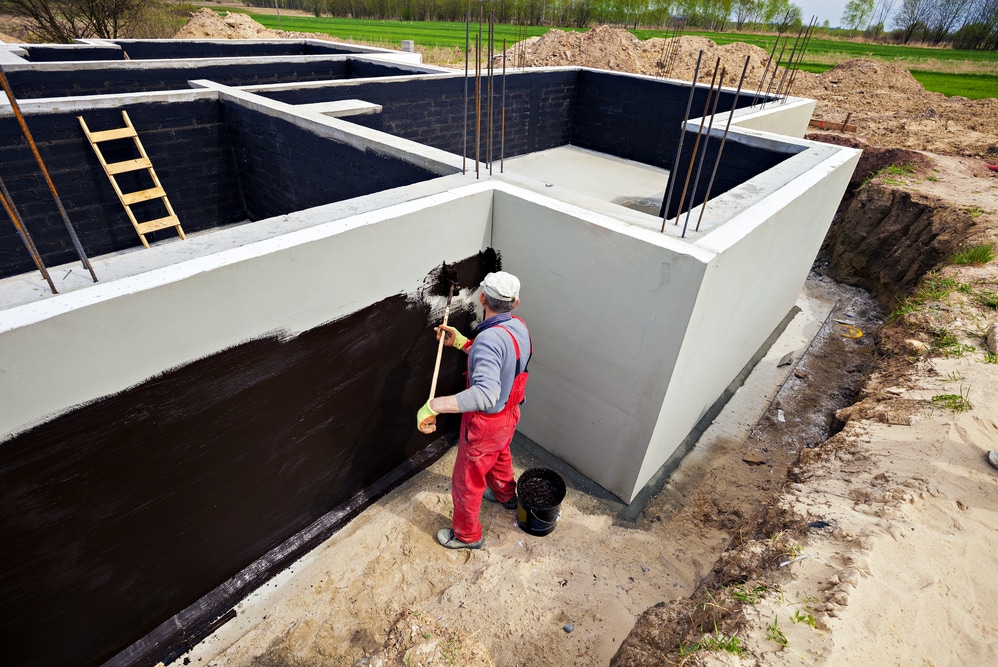Like many components of a building project, some of the most important are never seen. This is certainly the case with below-grade waterproofing, which can have a lasting impact on a building's lifespan and performance. Let's explore the factors that determine when below-grade waterproofing is needed and how it should be designed.
Potential Causes of Below-Grade Water Infiltration
When considering the possibility of water infiltration through the building foundation, there are three primary forces at play.
Water Table
Water table (or the "groundwater line") is the level at which the soil under the building becomes saturated with water. If the building foundation is below the groundwater line, then it will be subject to water infiltration due to hydrostatic pressure.
Hydrostatic Pressure
Hydrostatic pressure is the force that water-saturated soil imposes on a building's foundation. Increasing with depth, it puts additional loads on the foundation, forcing water into any cracks in the structure.
Capillary Action
Capillary action (or "wicking") is the ability of water to flow against gravity into narrow crevices in the soil due to water molecules' interaction with the surfaces of the materials. Depending on the soil type, capillary action can cause water to rise as much as six feet above the water table, where it may then travel along materials and gaps in the foundation and enter the building.
So, if hydrostatic conditions that could affect the foundation are present, below-grade waterproofing is imperative.
Understanding Below-Grade Waterproofing
There are two main categories of below-grade waterproofing. The best approach depends on a number of factors, including the project's foundation design, soil conditions, and surrounding infrastructure.
Positive-Side Waterproofing
Also known as "exterior-side waterproofing" or "post-applied waterproofing," positive-side waterproofing is installed on the side of the substrate directly exposed to water after construction. Because the substrate is already constructed and fully accessible during application, the work can be quality-checked during and immediately after installation. The drawbacks to positive-side waterproofing are that it requires ample excavation space around the building, it is vulnerable to damage in the backfilling process, and once soil is backfilled against the foundation, further inspection is impossible.
The following systems are used in positive-side waterproofing:
- Liquid-applied membranes, such as Siplast TeraPROOF™ STP (silane terminated polymer), a single-component, elastomeric, cold-applied liquid membrane
- Prefabricated membranes of modified bitumen, elastomeric, or thermoplastic sheets
- Mineral-based systems, such as bentonite clay or crystalline
Blindside Waterproofing
When the exterior surfaces of foundation walls are inaccessible due to space restrictions, blindside waterproofing may be the only option. Blindside or "pre-applied" waterproofing is installed against adjacent lag piling or other earth-stabilizing structures before the foundation wall is constructed. It then bonds with the concrete foundation wall as it is placed.
Materials used in blindside waterproofing include:
- Modified bitumen membranes, like Siplast TeraPROOF™ Pre-Applied H-SBS and V-SBS (styrene butadiene styrene) membranes
- Polyvinyl chloride (PVC) and high-density polyethylene (HDPE) membranes
- Bentonite sheets
Ensuring the Success of Below-Grade Waterproofing Installations
Even the highest quality waterproofing products are subject to failure if they are not installed or protected properly.
Delivering a high-quality product is only part of the equation. It's equally important to back it up with comprehensive contractor training, service, and ongoing support. Siplast's approach is to identify key contractors in every market, providing thorough training and gathering feedback on additional products they may need. This collaborative approach helps ensure successful installations and drives continuous product improvement.
Here are some other considerations that are critical to below-grade waterproofing success:
- Store materials properly before installation. Depending on their chemical composition, temperature extremes or exposure to the elements could negatively affect materials. It's important to follow manufacturer's instructions.
- Properly prepare and protect the substrate. A cracked, defective, or poorly prepared substrate makes it impossible to correctly install the waterproofing. In blindside applications, the installed waterproofing becomes the substrate for the concrete applications and has to remain clean to properly bond to the placed concrete. In blindside applications where deep foundation walls are being constructed in multiple lifts, concrete overspray and splashing can create contamination for the next lift, which breaks the membrane-concrete bond.
- Institute quality control measures before and during installation. These should include preconstruction meetings with all parties concerned; field quality control tests for substrate conditions, surface preparation, and ambient conditions; and detailed records of all inspections, tests, material certifications, and material installation techniques.Follow all industry-accepted protocols and testing guidelines.
- Ensure waterproofing is flashed and detailed per the manufacturer's instructions. Gaps in the integrity of the waterproofing or inadequate reinforcing at corners can lead to failure. Flashing penetrations and sequencing material correctly are important to the overall performance of the waterproofing system. Design documents should include typical details for reinforcing and/or flashing corners and penetrations.
- Specify material that doesn't shrink. Siplast TeraPROOF™ STP liquid membrane, for example, is a moisture-cured product that does not shrink after application, unlike traditional low-solids, solvent-based, or water-based liquid materials.
- Install recommended protective layers, drainage layers, and waterstops. These components, like Siplast TeraPROOF™ Protection CS1000, help manage water and prevent damage to the waterproofing after installation. Siplast provides all of these, as well as a specially developed protection mat for horizontal applications.
- Require a warranty. Specifications should include a requirement for a single-source warranty that ensures compatibility and uninterrupted coverage with the project's above-grade commercial wall systems and waterproofing systems. Siplast provides a complete scope of building enclosure products.
For more information about these and other waterproofing products, explore Siplast's high-performance roofing systems.


